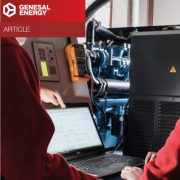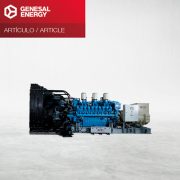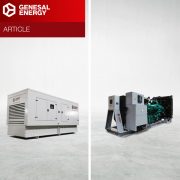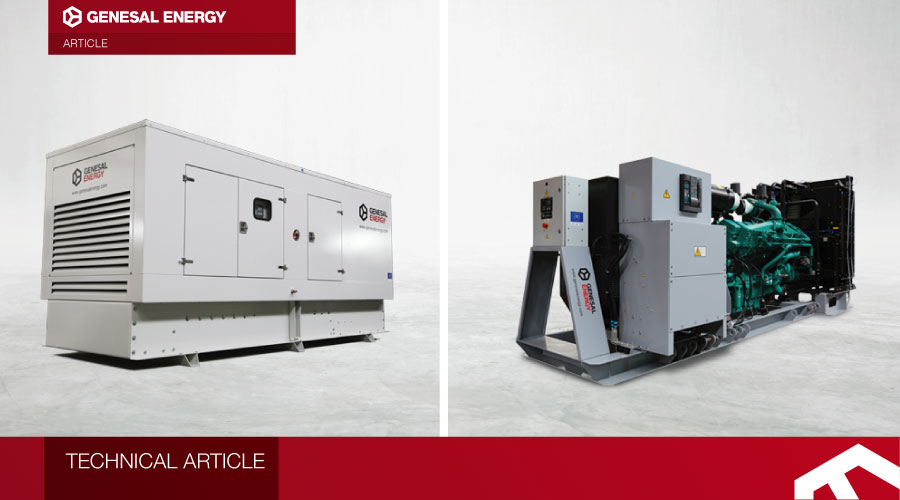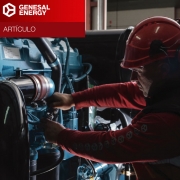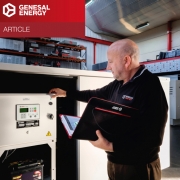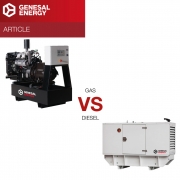Do you know what Stage V emission standards are? We’ll explain!
/in Articles, Communication/by GestorIndustrial communication systems in generator sets: Latest updates and protocols in the 4.0 universe
/in Communication, Articles/by GestorInstallation and Arrangement of Generators
/in Articles, Communication/by genesalGenerators are divided into different categories according to the way and the place they are installed. We will explain to you what those categories are.
Equipos móviles para obras o proyectos en zonas aisladas, generadores de emergencia estáticos situados en el interior de fábricas, grupos electrógenos exteriores operando en áreas densamente pobladas… Todos ellos necesitan cumplir diferentes requisitos, que acaban marcando su diseño y su tipo de montaje.
Aunque esos requisitos pueden ser diversos y numerosos, se puede decir que hay 3 variables básicas que acabarán caracterizando a un generador:
- First of all, the mobility which will be required by the generator. Are we talking about a generator which will be installed in a fixed location, never to be moved again, or is it a generator which will be used in various locations?
- Secondly, its isolation from the environment. Will the generator be installed inside a building or will it be located outdoors?
- Finally, the acoustic requirements of the environment in which it will be installed. Will it be of critical importance to maintain a low level of decibels or will there be no restrictions in matters of acoustic pressure?
Once these questions are answered, we will be able to choose the type of generator most suited to the requirements of our project.
The basic types of installation
Despite the fact that there is an infinity of personalization options, there are 3 types of installations according to the parameters mentioned above.
1. The open stationary installation
This type of installation is foreseen for projects in which the generator is installed inside a building and it does not need to be moved once installed. Consequently, the generator does not need any casing to protect it from inclement weather, nor does it have any mobility device.
The generator will be installed on a steel bedplate (with or without an integrated fuel tank), capable of sustaining the static mechanical requirements, as well as the vibrations to which the generator will be subjected throughout its service life.
2. The stationary sound-damping installation
When the generator will be exposed to bad weather conditions, will be stationary and the sound level it produces will have to be low, this type of installation is the ideal one.
The generator is encapsulated in a galvanized steel cabinet, protecting it from inclement weather. The inner part of the hood is covered by sound-damping material, which allows for the reduction of the sound level which is emitted. Therefore, this type of installation is adequate in applications where noise is a crucial factor.
3. The mobile sound-damping installation
This is the type of generator which is usually seen in provisional installations (events, film shootings etc.). Its differentiating feature is that this type of generator must have the possibility to be moved to where energy is required; consequently, it will be installed on a trailer.
The device is placed on some special anti-vibration dampers, capable of sustaining the sheer stress (or lateral deformation) which can happen during circulation: factors such as braking, acceleration or bumps. In this way, one manages to protect the monoblock (the engine-alternator group) and to ensure the generator’s functioning and durability.
At Genesal Energy, we provide generators adapted to these three generic categories of installation and arrangement. They can be further personalized in order to adapt in the best way possible to the specific applications that our customers need.
DISCOVER MORE OF GENESAL ENERGY’S PROJECTS
Speed regulation on generators: power without ups and downs
/in Articles, Communication/by GestorWhat we demand of a generator is a stable power delivery. And a constant engine speed is crucial in achieving this.
The famous Swiss architect Le Corbusier said that machines are “a fantastic perfection tool”. However, experience tells us that even the most sophisticated machinery is not perfect. Although the mechanical systems are designed to be balanced and deliver based on optimal parameters, one must take into account that there are always some factors which can alter their efficiency.
The speed of an engine, for example, may be affected by a drop in voltage or by power surges. And, in the case of generators, such variations are of critical importance, given that the engine speed directly determines its operating frequency.
Logically, this can entail a problem, because the thing that interests us about a generator is that it be capable of maintaining the most stable power possible around a certain value.
The good news? Everything is foreseen and technology provides us with the solutions for the engines never to lose direction.
Regulating a solid response: generator speed control
At present, the engines powering electrical generators contain a speed regulator for speed control.
The function of this regulator is to detect any imbalance in the engine speed and to cause it to revert quickly to its optimal working regime.
Thanks to this device, our generator’s engine will always keep a constant rhythm. In this way, the generator will be capable of always complying with the requirements of the load, giving us the power that we need to obtain.
Moreover, the speed regulator acts as a security device, because it protects the engine from excessive speeds which can cause the engine to break down.
Genesal Energy: reliable engines
At GENESAL ENERGY, we offer you diesel generators equipped with three different types of governed engines:
- Engines with mechanical controls
- Engines with mechanical controls and inbuilt electronic controls
- Electronic engines
All of these are designed to recuperate the working frequency, both after a load impact and after a sudden drop thereof.
The response to the drop in frequency will depend on:
- The inertia of the engine itself.
- The inertia of the alternator.
- The characteristics allowed by the installed AVR (Automatic Voltage Regulator).
At the same time, in the engines with mechanical speed regulation, we apply a parameter called “speed drop” or “droop”. This parameter represents the percentage of over-speeding that the engine is experiencing when it is operating without a load, compared to the nominal speed (at full load). Once we have calculated this, we can configure the engine so that it quickly stabilizes when a load is applied to it..
All regulators need a certain period of time in order to act. At GENESAL ENERGY, we carry out all the necessary adjustments and tests to ensure that the regulators control the engine speed and the generator frequency correctly. In this way, we give a reliable response to our clients’ requirements.
DISCOVER MORE OF GENESAL ENERGY’S PROJECTS
Configuración web
/by Gestora:7:{s:8:”location”;a:1:{i:0;a:1:{i:0;a:3:{s:5:”param”;s:12:”options_page”;s:8:”operator”;s:2:”==”;s:5:”value”;s:14:”theme-settings”;}}}s:8:”position”;s:6:”normal”;s:5:”style”;s:7:”default”;s:15:”label_placement”;s:3:”top”;s:21:”instruction_placement”;s:5:”label”;s:14:”hide_on_screen”;s:0:””;s:11:”description”;s:0:””;}
Statement COVID-19
/in Communication, News/by Gestor
Dear suppliers and clients:
Due to the global pandemic caused by COVID-19 and following health recommendations as well as those by other administrations, at Genesal Energy we have adopted a series of preventive measures, while attempting to alter the company’s normal operation as little as possible, and remaining within the provisions, in their totality, contained in the Royal Decree 463/2020, of the 14 th of March, through which the current state of emergency has been declared for the management of the health crisis caused by the COVID-19. Therefore, from today onward, and, in principle, while the state of emergency lasts, all Genesal Energy staff members that are able to work from home will begin telecommuting, and new work shifts have been established in the different divisions in order to optimize resources in this exceptional situation. These decisions, which affect internal organization, have been made in order to minimize the impact of COVID-19 and as a question of social responsibility. This is our contribution to avoid spreading the virus and to be able to resume normal operation as soon as possible.
Although the company will continue, through all means possible, to operate at its usual level, we urge our suppliers and all clients who work with us to please cooperate by prioritizing communication via email (genesal@genesal.com) or through the e-mail address of each relevant staff member, as this will be the main channel of communication during the following weeks. In all cases, contact via our telephone number 981 674 158 will remain open.
On behalf of each staff member of the Genesal Energy group, we express our support to those affected by the coronavirus as well as our gratitude and solidarity to all health personnel who is working hard to keep the virus under control.
Sincerely,
Genesal Energy Board of Directors.
How do variables affect the sizing of a generator?
/in Articles, Communication/by genesal
Analyzing the effect of voltage and frequency drops is indispensable for deciding which engines and alternators are more adequate for a generator.
Voltages are not a static phenomenon. They fluctuate resulting in peaks and drops during certain phases of the equipment’s functioning.
In fact, when we speak about circuits we distinguish between two types of situations:
- The steady condition: It is the stationary situation of normal functioning in which the voltage ows in a balanced state according to the conditions determined by the network.
- The transitional state: it occurs in certain periods of time in which the voltages and electrical intensities vary, before the circuit comes to its steady state and becomes stabilized.
The voltage variations occurring during these transitional periods are known as variables.
When do variables occur?
Logically, the normal situation in which variables occur is when we cause a circuit to pass from one condition to another, i.e. at the moment of connecting or disconnecting the equipment.
In fact, when we switch on and off a generator, short voltage peaks are triggered. Although they tend to end by themselves, we must not take them easily. Why is that? Because if the alternator and the engine happen not to be capable of coping with them, major functioning problems may ensue in the generator.
A matter of analysis
For this reason, in the process of designing and sizing a generator, it is indispensable to carry out a strict variable analysis.
Do you want to know the keys to be able to do this analysis?
At Genesal Energy we advise our clients and offer them the solution which best adapts to their project.
Discover how to configure your generator set
Diesel and Gas Powered Generators: What is the difference?
/in Articles, Communication/by genesal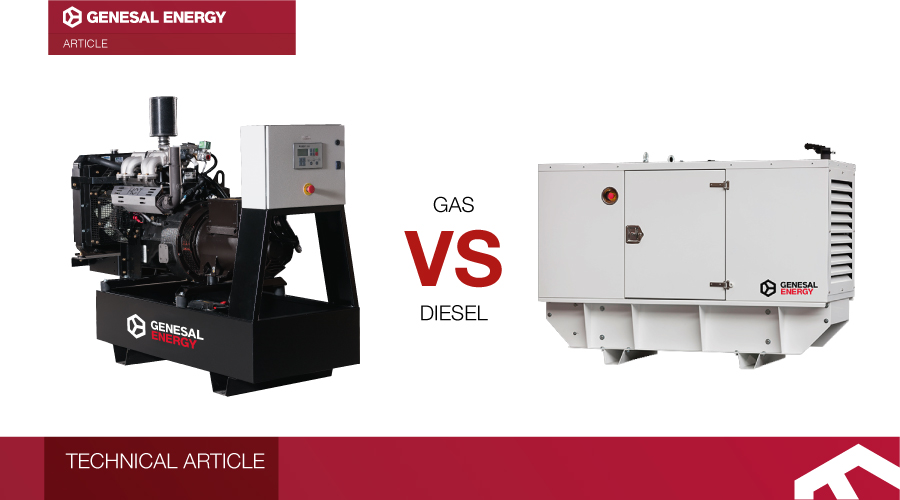
The two most common generator types on the market are diesel engine powered generators and those using gas powered engines.
Apart from the fuel powering them, they have other distinctive qualities which make them more or less adequate according to the use we want to give them.
Let’s see what they are.
Diesel generators
The reliability of a classic
For quite a long time, diesel engine generators have been a standard in the market. Their good reputation was the result of a great flexibility of application, both in industrial and household areas, as well as their robustness and reliability.
This type of generator may be used as a main power supply, as well as for co-generation or emergency applications. They are fully autonomous and may, therefore, function in places which have absolutely no power-supplying networks.
What advantages have made diesel generators so popular?
- They are more easily disassembled and installed than gas units, making their installation wherever needed a simpler task, while also using a fuel which is easily accessible and more economical than gasoline.
- They are robust and sustainable, capable of ensuring many hours of yearly operation.
- Diesel fuel gives high efficiency to the equipment using it because it burns at a much higher temperature than gasoline.
- Diesel fuel is also very safe because it is less flammable than other types of fuel.
The main disadvantage of this type of generator, as in the case of any machinery which includes a diesel engine, is that it causes high levels of polluting gas emissions. Therefore, the present day diesel generators incorporate an additional antiparticle filtration system that ensures its conformity with the legislation in force.
Natural gas powered generators
Clean and economical energy
Gas engine generators have gained much popularity due to their great reliability, cost efficiency and sustainability.
This type of generator can be used as a primary power source, in co-generation applications or as an emergency source and its engine may be fuelled by liquefied natural gas (LNG) or liquefied petroleum gas (LPG). The latter is a gaseous fuel obtained from the distillation of oil.
Generators powered by LNG fuelled engines get their fuel from the natural gas distribution network, whereas LPG fuelled generators are connected to a tank which will have to be periodically refuelled.
What are the benefits of natural gas powered generators?
- They are more respectful of the environment, because the gas causes less emission than other non-renewable fuels (such as coal, diesel or gasoline).
- They are economical, because gas is the most affordable fuel, second only to coal (which is not an option due to its high emission level).
- They are high-efficiency generators in co-generation applications.
- When fuelled by an underground natural gas network, the fuel supply is not conditioned by inclement weather or problems with the communication infrastructure (which do condition diesel generators that need periodic refuelling).
- They are highly compatible and easy-to-use units, given that it is possible to install them in remote locations, using high capacity tanks.
- They are very quiet generators.
Among the disadvantages of this type of generator, one must consider the following:
- Liquefied natural gas (LNG) powered generators are less autonomous than diesel engine ones because it is absolutely necessary to connect them to a distribution network.
- In the case of LNG equipment connected to the network, one has to take into account that any catastrophe or natural disaster can affect the supply system.
- Gas is an exceptionally flammable fuel and entails a bigger fire hazard than diesel.
- The engine and control system are much more demanding, which can result in the product’s final price being higher.
- They require a more punctual and complex maintenance.
Diesel vs Gas Generators?
Choosing one type of generator over the other is a decision which involves taking into account numerous variables, some of which are not always obvious.
At Genesal Energy, we advise our clients, offering them the solution which is most adequate to their projects.
For more information, please contact us at:
consultas@genesal.com +34 900 730 124
Contact
Do you need a generator set?
Fill in the form with your information if you want one of our generator sets or if you have any questions. We will prepare a quotation for you. We will prepare a quotation for you based on you requirements.

Customer Service Telephone/Fax:
+34 900 730 124Customer service team Email
consultas@genesal.comGENESAL ENERGY
INTERNATIONAL
We operate in over 30 countries worldwide.
EUROPE | AFRICA | LATIN AMERICA | MIDDLE EAST
R&D+i
GENERATOR SETS
- Diesel Generator Sets
- Gas Generator Sets
- Hybrid Generator Sets
- Stage V Generator Sets
- REQUEST A QUOTE
CERTIFICATIONS






COMUNICATION

Parroquia de Rois, b28
Polígono Industrial de Bergondo 15165
Bergondo, A Coruña
consultas@genesal.com
EEE Producer Registration Number EE 7087
Members of

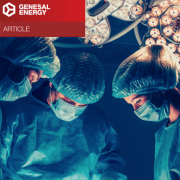
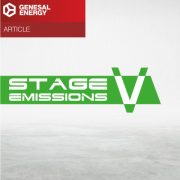 Genesal Energy
Genesal Energy